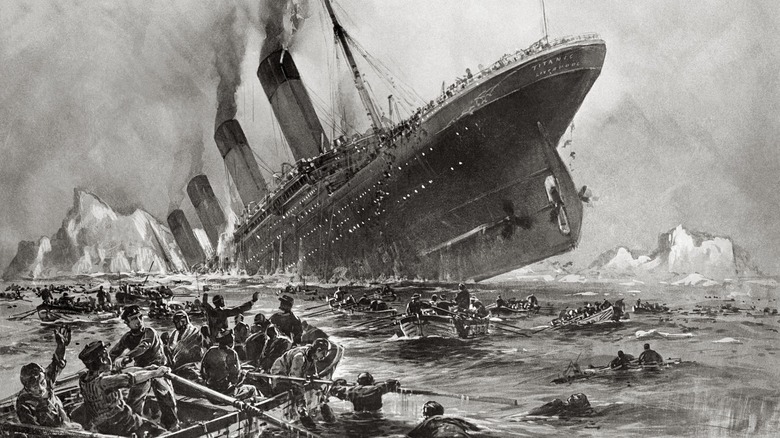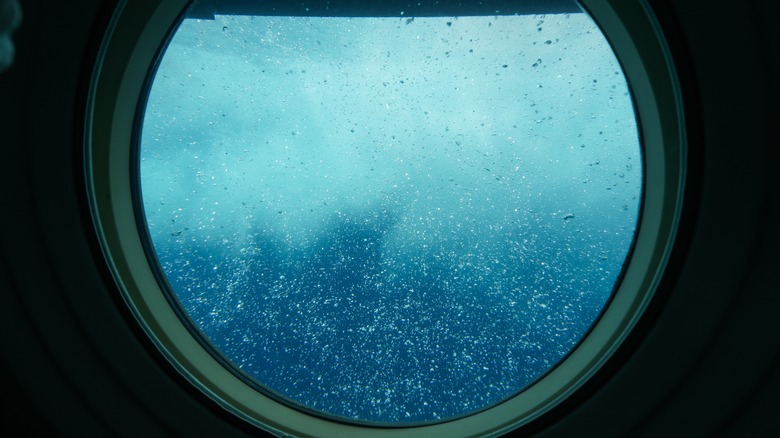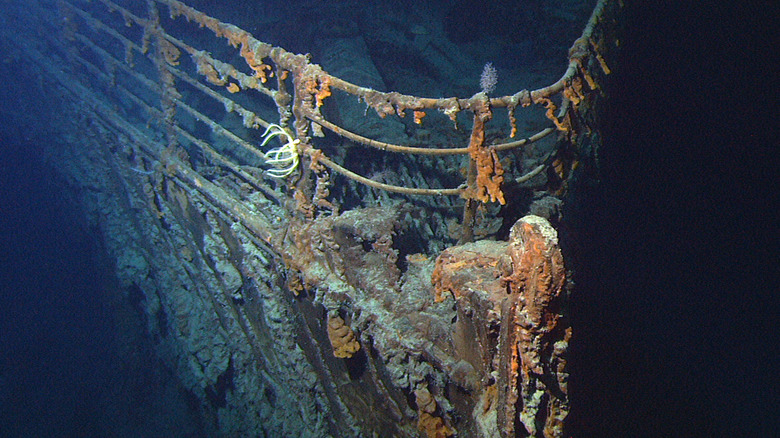Why The Titanic Isn't Crushed
The tragic destruction of the OceanGate's Titan exploration vessel in 2023 left folks with a lot of questions. Chiefly: What exactly happened when the submersible lost contact with its support ship 1 hour and 45 minutes into its descent? Was there a structural defect in the Titan that led to its implosion? Was it human error? What did those on board see and feel before the sub imploded? For better or worse, research scientist Steve Somlyody told Fox News that those on board the Titan "wouldn't even know it happened."
Not every vessel that sinks in the water implodes, though. As we can see in The New York Times, the Titanic might be a decrepit, crumbling mass at this point, but it still has its original boat shape — and it's been sitting 13,000 feet under the surface of the ocean since 1912. But the deeper underwater you go, the stronger the pressure gets. As Scientific American says, pressure increases at a rate of 15 pounds per square inch (psi) every 10 meters (33 feet) below the surface. That means for the first 10 meters down — snorkeling depth, basically — the water pressure feels about the same as the air pressure when you're walking around on the beach. Below that, things start to feel really compressed really quickly.
If a vessel is designed to be a perfectly airtight, self-contained bubble like a submarine, but has some defect? It'll get instantly crushed from the outside. The Titanic, on the other hand, isn't a sealed vessel like the Titan was — and thus hasn't been affected by pressure in the same way.
[Featured image by Willy Stöwer via Wikimedia Commons | Cropped and scaled | The Library of Congress Prints and Photographs Division]
Under pressure
Water pressure is no joke. As Scientific American explains, the pressure felt when underwater comes from the water above you. That's why things feel more compressed the deeper you go into the ocean — the entire mass of the ocean is sitting above your head. And so, the National Oceanic and Atmospheric Administration says that lifeforms that live deep in the ocean lack organs and internal structures that hold air, like bladders or lungs, because their bodies wouldn't be able to press out against the water pressure.
And down at the Titanic's depth? HITC says that the pressure per square inch equals around 6,000. That's 400 times the pressure pushing on a manmade machine or human body than on the surface of the water. So no, you wouldn't survive for one fraction of a second down there unless protected in an airtight, submersible shell. And yes, a submersible would crumple in an instant if it had the slightest defect or crack somewhere. Death would be instant.
In fact, the pressure is so severe in the deepest depths of the ocean that folks have to rise slowly to avoid getting decompression sickness, aka "the bends." Harvard Medical School says that decompression sickness symptoms include joint pain, dizziness, numbness, difficulty thinking, you name it. And when descending into the deep Hodinkee says that the pressure inside a submersible needs to stay equal to the pressure on the surface. It needs to push out as much as the water pushes in.
Consigned to the deep
To better understand why the Titanic didn't crumple like a paper ball when it sank to the bottom of the ocean, we can look at a simple comparison. The Washington Post says that a car door faces up to 600 psi of pressure if a car dives into the water. So if you fly off a pier you'd have to be pretty dang jacked in order to push the door of your car open. But that's only because of the difference in pressure between the inside and outside of the car. Open a window and the pressure differential vanishes because water floods inside.
The Titanic, on the other hand, sits at a depth subjected to 6,000 psi. That's 10 times more than your hypothetical car door. Flat, slabs of steel won't get squished down there like slices of bread. Neither will the railings on the deck or any objects inside — at least anything that's not filled with air or hollow cavities. By the time the Titanic hit bottom, any pressure differentials across its hull or throughout its interior sections had long balanced out. Much of the current decay and decomposition we see across the Titanic (see the above picture) comes not from water pressure, but from the exchange of oxygen molecules between metal and water, as The Shipwreck Project explains. So for now it seems the wreckage of the Titanic is safe ... if anyone is willing to risk the journey.
[Featured image by NOAA/Institute for Exploration/University of Rhode Island (NOAA/IFE/URI) via Wikimedia Commons | Cropped and scaled]


